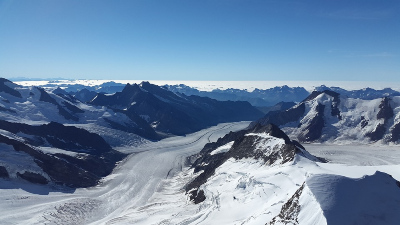Have you ever seen the movie Ice Age? The 2002 computer-animated film shows the beginning of the Ice Age: massive glaciers and ice shields form and cover the landscape, forcing all animals to flee. In real life, glaciers also transform, they grow or melt – and they move. But how is it possible for such a huge mass of ice to move?
First, we need to look at how glaciers actually form.
If snow falls in one place over many years, and stays there all year long, it slowly starts to develop into ice. The snow that falls on top of the snow that is already there presses down on the snowflakes, and as this process continues over decades and centuries, the density increases until the snow has finally transformed into massive ice. The wind also shapes and changes the glacier. In addition, a glacier also contains rocks, rubble and water. Today’s glaciers are often the remains of ice sheets from the Ice Age more than 10,000 years ago.
You can define the anatomy of a glacier in the same way as you can for animals: The head is where the glacier starts and the foot is where it ends.
The upper part, near the head, is where something called accumulation happens. In this zone, more snow falls than melts, so it piles up, or “accumulates” in scientific terms. This zone is further divided into different zones depending on the consistency of the snow or ice. Many glaciers are hundreds or even thousands of years old and have accumulated so much ice over the years that they are hundreds of metres thick – ice shields up to two kilometres thick have been discovered!
The point where the ice melts as much as the snow and ice accumulates is called the equilibrium line. In the fracture zone, beware of crevasses! These are huge cracks in the ice that can be several hundred metres deep and are one of the main reasons why walking on glaciers can be dangerous, as they are often hidden by snow.
The last zone left is the ablation zone. This is where the glacier melts or breaks down and ends in the glacier foot. Often you can find lots of rocks and rubble that have been pushed downhill by the glacier in moraines (when the glacier has retreated), and the melting water flowing out of the glacier forms a stream or lake.
Speaking of flowing streams: Glaciers are sometimes called “rivers of ice“. It sounds paradoxical, but it is true: the ice moves slowly and flows downhill. Apart from Antarctica, where we find huge ice shields that move in all directions, and the piedmont glaciers that spread out at the foot of glaciated regions, there are also mountain glaciers. They flow along a path or slope. It is their anatomy that we have already looked at.
The main reason for their movement is gravity. The glacier often starts high in the mountains and the ice is very heavy, so it is pulled downhill. But there are three other types of motion:
Basal sliding occurs when there is melting water and soft sediment in the glacier bed, so the ice ‘slides’ down – often at a speed of about 1 metre per day. When the weight of the heavy ice pushes the ice crystals close to the bed and transforms their shape, this is called internal deformation and is the second way a glacier can move.
Sometimes the glacier moves very fast in a very short time in what are called glacial quakes. These can be very strong, but only happen when the glacier is not completely frozen and is flowing faster than 1 kilometre a year. Unfortunately, the number of these glacial earthquakes is increasing.
If you are wondering how fast these huge masses of ice can move, here is the world’s top 1 fastest glacier: The Jakobshavn Glacier in Greenland reaches speeds of up to 40 metres per day!
Over thousands of years, rivers of ice have shaped the landscape, creating valleys and hills. All over the world, from Greenland and Antarctica to many mountain regions, you can find glaciers and how they have shaped the environment. It is estimated that 10% of the Earth’s landmass is covered by glaciers, and about 2% of all water is frozen in them. The next figure is even more impressive: almost 70% – more than two-thirds – of all fresh water is “stored” in these rivers of ice.
Unfortunately, global warming due to climate change can change this:
A glacier can grow or shrink – but if it melts faster than it grows, it will shrink. This is called glacier retreat. Many glaciers have retreated or even completely vanished in recent decades, and many are seriously threatened. Scientists have calculated that if all the world’s glaciers melted, sea levels would rise by 90 metres – about the height of the Statue of Liberty in New York and almost as high as Big Ben in London!
As you can see, glaciers are fascinating, beautiful and essential to the Earth’s water cycle – sometimes dangerous, but also endangered. Unlike in the film Ice Age, we do not need to run away from them, quite the opposite: We must stop global warming to prevent them from melting.
References:
- https://en.wikipedia.org/wiki/Glacier – Wikipedia, accessed 15/02/2023
- https://en.wikipedia.org/wiki/Ice_Age_(2002_film) – Wikipedia, accessed 15/02/2023
- https://asf.alaska.edu/information/glacier-power/glacier-power-how-do-glaciers-move/ – Alaska Satellite Facility, accessed 15/02/2023
- https://study.com/learn/lesson/glacier-movement.html – Study.com, accessed 15/02/2023
- https://en.wikipedia.org/wiki/Glacial_motion – Wikipedia, accessed 15/02/2023
- https://education.nationalgeographic.org/resource/glacier – Tyson Brown et al., National Geographic, accessed 15/02/2023
- https://www.britannica.com/science/glacier – Mark F. Meier, Encyclopaedia Britannica, accessed 15/02/2023
- https://www.usgs.gov/special-topics/water-science-school/science/glaciers-and-icecaps – U.S. Geological Survey, accessed 15/02/2023




